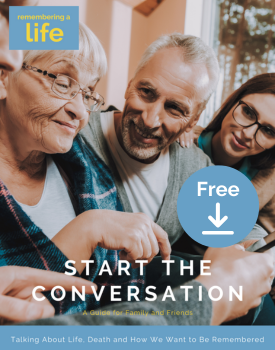According to a thorough study conducted by Edison Research, last year, approximately 223 million Americans used social media. The study additionally found that most people who are members of social media sites use their chosen platforms daily, and while we may still automatically associate many of these sites with youth as their primary users, younger adults and middle-aged adults engage these social networking venues at a nearly equitable rate to adolescents at this point in time.
When someone we care about has experienced a death loss, many of us will send a condolence card or letter, pick up the phone to extend direct sympathy, or – in ordinary times – stop by with flowers or food. However, it is more common than ever to learn about a loss via social media and therefore use these platform to express our initial condolences. Social media, including memorialization websites, can be invaluable in remaining in touch with grieving loved ones who are separated by us through distance; at the same time, using these platforms to express grief support can also feel like stepping carefully through a minefield.
I’ve had the great pleasure to teach thousands of emerging adults in higher education, all of whom have grown up immersed in social media and who speak readily to the help and to the harm they have experienced and witnessed through online responses in times of personal loss. In soliciting practical advice on how to maximize support to others in their lives who are grieving, they often describe having felt:
- Overwhelmed by the number of impersonal and nearly-identical responses they received to posts on their deceased loved one;
- Anger at having learned that a loved one died by reading about it on social media before they could be contacted directly;
- Confused as to the “dos and don’ts” of supporting grievers in the digital age.
While I hope that the following strategies will be assistive to you in navigating social media support for grievers purposefully at any time, in our current cultural moment, maximizing our support for those experiencing a death loss is particularly needed. At the time of this writing, approximately 120,000 people have died of the novel coronavirus in the U.S. alone over the last four months. Each of those people has left behind a community of loved ones who are grappling with their unique losses. Those who have lost someone to death through means other than COVID-19 have similarly been directly impacted by the funerary restrictions, gathering limitations, social distancing, and travel complications that this pandemic has necessitated. For the first time in most of our lifetimes, widespread death and grief are at the center of public, national conversations, yet this health crisis is occurring at a time in which we are already heavily reliant on social media outlets as a means of communication and support.
Use Memorialization Pages With Purpose
Memorialization pages are a unique opportunity for grievers to continue bonds with their loved ones digitally and over time. When posting to a memorialization page, or to a death notification post, include specific memories of the deceased or memories that the griever shared with you about them that you found touching, memorable, or funny. Consider also referencing qualities the griever admired in their loved one that you believe they share with them or inherited from them. Grievers will often reread these posts when feeling particularly lonely in their loss; using specific detail will offer comfort that their loved one’s legacy is shared, even by those who did not know them well.
Anniversaries, birthdays, and other memorable dates will often prompt survivors to post to memorialization pages – we know that grief is ongoing and that we do not “get over it,” so posting messages of support on these dates can also help the person you care about continue to “get through it.”
Post Thoughtfully and With Care
One of the greatest cultural losses to living in a digital age is the amount of time we allow ourselves in which to reflect and respond to one another on a daily basis. We are so accustomed to rapid response and the expectation of scrolling quickly through a timeline or newsfeed that we may not always choose our words carefully.
When posting, consider others’ feelings as you reflectively write. Remember that you are not writing into a vacuum and that these sites are public spaces; the readership and audience of your words are much wider than simply the person or people you wish to support.
Speculation or questions about the way in which someone died, singling out someone as grieving more or less than another survivor, or accidentally sharing information about the deceased’s life that might not be known to everyone can cause long-term harm for someone who is using social media to share news of a death and to attain support.
Avoid Employing Empty Language
While posting online, resist language that may be harmful or might unconsciously disenfranchise grievers, including clichés and “at least” statements. Examples: “We’re never given more than we can handle,” “Everything happens for a reason,” “At least they did not suffer long,” “At least you had so much time with them.” These statements, while well-intentioned, signal to the griever that they should not be feeling the emotional responses that they are feeling genuinely and deeply. Rather, these phrases “police” grief.
Similarly, avoid socially-prescribed “grief scripts” such as “Sorry for your loss” and “Let me know if I can do anything to help” and try not to lean on emojis to communicate your emotional support. In short, choose your words carefully and with intention. If you wish to offer specific support, such as dropping off food or running errands, consider a means other than a public post in which to offer it.
Keep Your Online Responses Focused
Perhaps now more than ever, when our country is experiencing an unprecedented convergence of pandemic, extreme political discord, serious economic concerns, and racial tensions and divisiveness, it is far too easy to become distracted from the very real, personal, and individually-felt grief being experienced by those who are suffering death losses in the present moment.
Remember the purposes of posting a death notification to social media – to inform the community that a death has occurred, to affirm the loss and the grievers’ bonds with the deceased, and to seek and attain support. Responses to a social media death notification should remain wholly focused on meeting those needs – by acknowledging the loss that has occurred, by bearing witness to the grief experienced by survivors, and by communicating care and support. Reread your words before posting to ensure that you are not unintentionally hijacking another person’s grief post as a means to share political comments, discuss personal opinions about COVID-19, engage in speculation about the circumstances of the death, or make comparisons to your own losses.
Extend Support Beyond Social Media Platforms
Now more than ever, it is important that social media not be the beginning and endpoint of how we support those who are grieving a death loss. While posting a response to a death notification online might be the first step we take in showing support, it should not be the last. Calling someone who is grieving, particularly during the complications of COVID-19, can alleviate isolation and loneliness. Sending a card with a handwritten, personalized note can provide comfort as well as a keepsake for the griever to hold onto. Making plans to meet and to participate in memorialization rituals when it is safe to do so reminds grievers that their loved one’s death is not being overlooked or forgotten in the midst of national turmoil.
For other ideas and strategies to demonstrate care to those who are grieving, I encourage you to read my post, "Loss in a Pandemic: Supporting Grievers".
Don’t Share News of a Death Online Without Permission
Finally and importantly, do not post about a death or share an online death notification without explicit permission from the primary grievers or immediate family members. Death notifications should only be shared online with the permission of the author and only then when all the closest survivors have been notified through better means. The shock and trauma of learning about a close family member’s death through social media can be immeasurable. On this topic, I share the astute observations of Daniella Markowski, RN, BSN, whom I was privileged to teach throughout her undergraduate studies, during which she experienced the sudden death of her father. In her senior honors thesis, The Complicated Process of Disenfranchised Grief While in College, she wrote:
In the event that a death notification emerges on a social media feed unexpectedly and is seen for the first time (i.e., scrolling through Facebook to learn for the first time that a family member has died in an accident), the shock from a depersonalized notice may enhance the already-existing grieving complications associated with an unexpected death. This does not take into account the accuracy of the information posted; if confusing details begin to emerge behind a screen, it may be more difficult to learn the truth, further complicating grief and paving the way for the griever to be excluded from knowing truthful information.
Social media has been labeled both revolutionary and reckless, but all agree that it is here to stay. It is important that we utilize these platforms with purpose when first responding to the news of someone’s loss, but it is even more valuable that we maintain the personalized care that is most needed when experiencing grief, both within and beyond social networking platforms. Through this pandemic and into our uncertain future, it is most crucial that we practice the compassion, empathy, and support that benefit anyone and everyone in troubled times – and no one more so than those who are suffering as the result of the death of a loved one.


